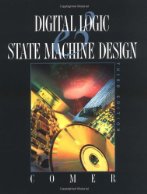From one of the best-known and successful authors in the field comes this new edition of Digital Logic and State Machine Design. The text is concise and practical, and covers the important area of digital system design specifically for undergraduates. Comer's primary goal is to illustrate that sequential circuits can be designed using state machine techniques. These methods apply to sequential circuit design as efficiently as Boolean algebra and Karnaugh mapping methods apply to combinatorial design. After presenting the techniques, Comer proceeds directly into designing digital systems. This task consists of producing the schematic or block diagram of
the system based on nothing more than a given set of specifications. The design serves as the basis for the construction of the actual hardware system. In the new Third Edition, Comer introduces state machines earlier than in previous editions, and adds entire chapters on programmable logic devices and computer organization.
Features
- Fills the need for a concise, practical text on digital system design at the undergraduate level. Features completely new chapters on programmable logic devices and computer organization. Written by one of the best-known and most-respected authors in the field.
Introduction to Digital Systems
1.1Overview
1.2The Integrated Circuit
1.3Design and Analysis
1Binary Systems and Logic Circuits
1.1The Advantages of Binary
1.2Number Systems
1.3The Use of Binary in Digital Systems
1.4Logic Gates
1.5Logic Families
2Boolean Algebra and Mapping Methods
2.1Boolean Algebra
2.2Karnaugh Maps
2.3Variable-Entered Maps
2.4Realizing Logic Functions with Gates
2.5Combinational Design Examples
3Logic Function Realization with MSI Circuits
3.1Combinational Logic with Multiplexers and Decoders
3.2Standard Logic Functions with MSI Circuits
3.3Design Problem Using MSI Circuits
4Flip-Flops, Counters, and Registers
4.1The Bistable Multivibrator
4.2Flip-Flop Applications
5Introduction to State Machines
5.1The Need for State Machines
5.2The State Machine
5.3Basic Concepts in State Machine Analysis
6Synchronous State Machine Design
6.1Sequential Counters
6.2State Changes Referenced to Clock
6.3Number of State Flip-Flops
6.4Input Forming Logic
6.5Output Forming Logic
6.6Generation of a State Diagram from a Timing Chart
6.7Redundant States
6.8General State Machine Architecture
7Interfacing and Design of Synchronous Systems
7.1Mainly Synchronous Systems
7.2Top-Down Design
7.3Design Procedures
7.4Design Examples
7.5Micscellaneous Aspects of State Machine Design
8Programmable Logic Devices
8.1Introduction to Programmable Logic Devices
8.2Read-Only Memory
8.3Programmable Logic Arrays
8.4Programmable Array Logic or PAL®
8.5Combinational PLD-Based State Machines
8.6State Machines on a Chip
9Digital Computing
9.1The Digital Computer
9.2Binary Arithmetic
9.3Arithmetic Circuits
9.4Memory Circuits
9.5The Control Unit
10Asynchronous State Machines
10.1The Fundamental-Mode Model
10.2Problems of Asynchronous Circuits
10.3Basic Design Principles
10.4An Asynchronous Design Example
Appendix 1Logic Families
Appendix 2Pulse Generating Circuits
Answers to Drill Problems
Answers to Selected Problems
Index
This book is intended as a text for sophomore-junior courses in digital desgin for electrical engineering, computer science, and electrical engineering technology students.


